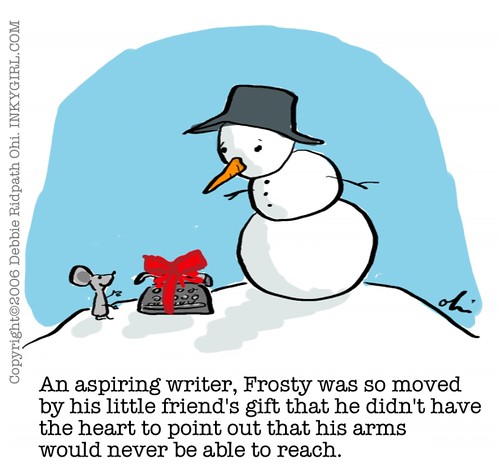First it was music, then it was books, soon it will be stuff.
Years ago, when it became easy for someone to replicate music from digital files in their own homes, music stores faced major issues. Now, when ebooks are finally reaching a similar status, bookstores are facing similar issues.
Soon, could it be virtually any retailer out there cringing because consumers will have the ability to just print whatever stuff they need right in their homes?
Entirely possible I suppose.
In the
most recent episode of
Spark (a CBC radio program that is also a podcast and blog), there was a great discussion and interview about
3D printers. (3D printers basically create a three dimension object by outputting successive layers of material, the same way a printer (AKA 2D printer) outputs ink onto paper.
At first, the technology sounds like magic (ie, like the replicators on Star Trek that can produce virtually anything seemingly out of thin air), but as it is explained so wonderfully on
Spark, the materials needed to produce the object are often stored in a paste/liquid format the same way that ink is stored and accessible by the printers we are familiar with. So it doesn't produce items out of thin air - but still, the ability to replicate items using a 3D printer and a digital blueprint is amazing.
The discussion on Spark involved material printers (and walked through the creation of a metal gear that takes about 20 minutes to produce) as well as food printers (discussing the incredibly complex and wonderful designs one might be able to do with a food printer which would be impossible to do using convention cooking methods), but it gave me two interesting ideas.
For the first one, I should pop back to my own experiences using an Espresso Book Machine. An EBM is a machine that uses print-on-demand (POD) technology to print, bind and trim a book in about 5 minutes. The
bookstore at McMaster University where I work has such a machine. (I like to call it "Mippy" - short for
McMaster Innovation Press) We're able to receive digital files from publishers or pulled down from a secure network of close to 2 million titles, and produce perfect bound paperbacks virtually indistinguishable from paperbacks produced by real printers.
 |
| Me posing in front of the EBM 1.5 at McMaster with books printed on our machine |
We bought the machine because we foresee a trend within the book industry that'll further optimize current physical distribution models (particularly as ebooks become more popular) and allow a small local bookstore to print titles upon customer requests. Currently, with a store that has an
Espresso Book Machine (and there are almost in North American bookstores -
click here for a list of EBM locations worldwide), you can walk in, request a title they don't have, and the bookstore can either order the book through convention methods (which may take anywhere between 3 days to 6 weeks depending on where the publisher's warehouse is located), or, if it is available as POD through the
EspressNet catalog, the store might be able to print the book for you within a matter of minutes and you can get it, still warm from the printer.
So now back to the concept of a 3D printer.
I was thinking of a local neighbourhood hardware store, particularly one in a more remote community, where quick and easy access to special ordered products for their customers are problematic. Imagine them owning a 3D printer pre-loaded with various metatic pastes. They could use the machine to produce rare nails, screws and other widgets that they wouldn't normally stock, all built from a catalog of virtually millions of possible items.
Sounds like a possible realistic use for a 3D printer. But why would anyone go to the hardware store when they could get a 3D printer for their home and just produce it there? Perhaps for the same reasons you go to your local hardware store now rather than a generic super-store that might carry the small parts you need. Expertise, advice, discussion. There's still a wonderful hardware stock on my block that can sell you a bag of nails just like in the old days, rather than a pre-packaged plastic box of them. Less packaging, greater expertise when you're doing work around your home and need to consult with a hardware expert.
With this new technology, soon it will no longer be just booksellers who will be looking at what it is that makes their physical presence desireable in their communities. Virtually any other retailer that carries stuff will be facing this.
One of Nora's guests talked about shoe stores, for example, particularly when shoes are mass produced yet don't perfectly fit anyone - imagine being able to produce shoes custom fit to you from a machine in your home? Cool idea. But, affording a machine like that doesn't come easy. So what about a local shoe store that can do the same thing? Keep a data file of foot sizes for their customers, link to a digital catalog of the latest shoe designs and be able to produce the exact size, fit and style their customers need right on the spot? Sounds practical to me.
The second idea that struck me regarding 3D printers involved what Nora and her guests discussed in interesting detail. 3D food printing.
Yes, I know, the idea of eating food produced by a machine isn't all that appetizing. But realistically, unless you're on a special rare diet or live on a farm and are eating mostly food you grow and prepare yourself, most of what you're eating is processed well beyond the food's original format.
I'm imagining the use of a 3D food printer in a way that might help people on special restrictive diets, or those who want to move away from
consuming animal proteins to do so without the current difficulties involved. I have some friends who are
vegans who work really hard and invest a great deal of time and effort into their diets, particularly because a lot of the foods easily available to them. And eating out can become somewhat of a comedy of errors for them.
But imagine a food printer filled with vegan-approved food source pastes and the ability to inject artificial flavours. You could produce from a virtually endless catalog of recipes, different textures, products, etc, all with different flavours and tastes, but guaranteed not to violate the dietary restrictions. Great for use at home, great for restaurants that want to mimic their regular menu with identical "vegan-safe" items.
Imagine the benefit to someone with a
peanut or other food allergy?
Interesting possibilities.
And that's what I love about listening to
Spark. I never leave without being given something really interesting to think about.






























